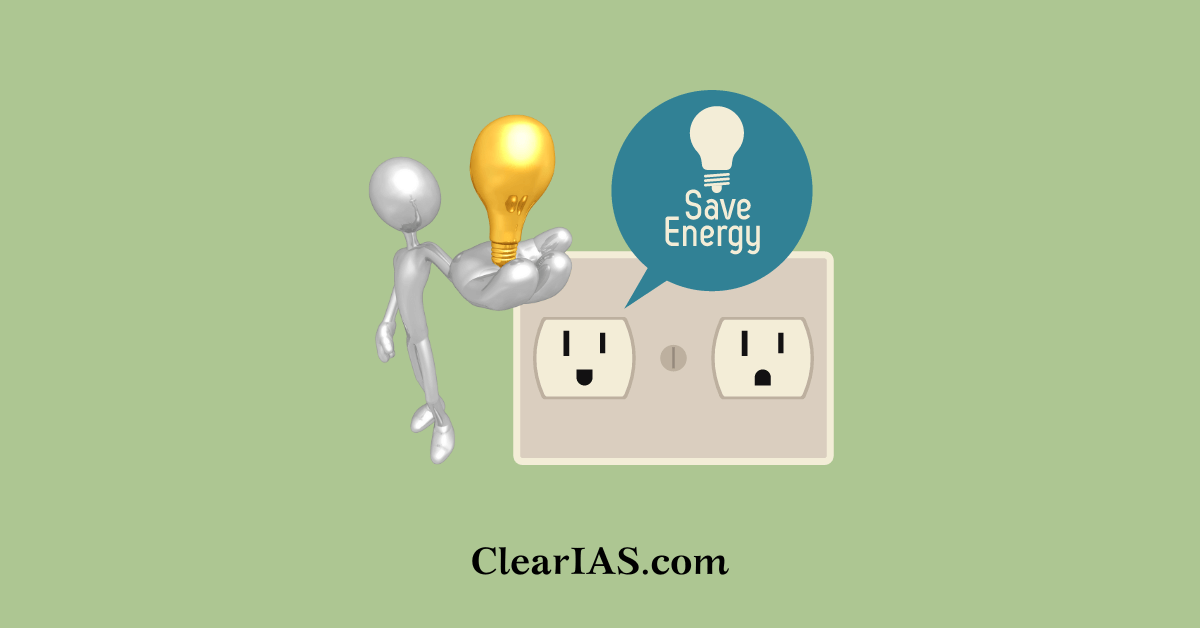
Initiatives to Promote Energy Conservation and Energy Efficiency
In this article, we discuss a few initiatives for Energy Efficiency and Energy conservation taken by the Government of India through the Bureau of Energy Efficiency (BEE), Ministry of Power.
1. Standards and Labeling by the Bureau of Energy Efficiency (BEE)
The Bureau of Energy Efficiency (BEE) initiated the Standards & Labeling program for equipment and appliances in 2006 to provide the consumer with an informed choice about energy saving.
The energy efficiency labeling programs under BEE are intended to reduce the energy consumption of appliance without diminishing the services it provides to consumers.
‘Star Rating’ mobile app
This app is linked to the Standards and Labeling database. It provides the user with a platform to compare personalized energy-saving devices across the same class and get real-time feedback from consumers so that they can make an informed purchase decision. Apart from being a one-stop solution for customers, it’s also a valuable tool for policymakers to access the accumulated data and analyze the feedback of the market at any given point in time.
2. Energy Conservation Building Codes (ECBC) by the Ministry of Power
The Energy Conservation Building Code (ECBC) was launched by the Ministry of Power for new commercial buildings in 2007. It sets minimum energy standards for new commercial buildings.
To promote a market pull for energy-efficient buildings, the Bureau of Energy Efficiency developed a voluntary Star Rating Programme for buildings which is based on the actual performance of a building.
The updated version of ECBC came in 2017 which sets parameters for builders, designers, and architects to integrate renewable energy sources in building design with the inclusion of passive design strategies. The code aims to optimize energy savings with the comfort levels for occupants and prefers life-cycle cost-effectiveness to achieve energy neutrality in commercial buildings.
3. National Mission for Enhanced Energy Efficiency (NMEEE) under NAPCC
The National Mission for Enhanced Energy Efficiency (NMEEE) is one of the eight missions under the National Action Plan on Climate Change (NAPCC). NMEEE aims to strengthen the market for energy efficiency by creating conducive regulatory and policy regimes and has envisaged fostering innovative and sustainable business models in the energy efficiency sector.
The NMEEE has four initiatives to enhance energy efficiency in energy-intensive industries which are as follows:
- Perform, Achieve, and Trade Scheme (PAT):
A market-based mechanism to enhance the cost-effectiveness in improving Energy Efficiency in Energy Intensive industries through certification of energy saving which can be traded.
Units that can achieve a specific energy consumption (SEC) level that is lower than their targets can receive energy savings certificates (ESCerts) for their excess savings.
The ESCerts could be traded on the Power Exchanges and bought by other units under PAT who can use them to meet their compliance requirements.
- Market Transformation for Energy Efficiency (MTEE):
Under MTEE, two programs have been developed i.e. Bachat Lamp Yojana(BLY) and Super-Efficient Equipment Programme (SEEP).
BEE promotes the use of LED lights using the institutional structure of the BLY Programme. SEEP is a program designed to bring accelerated market transformation for super-efficient appliances by providing financial stimulus innovatively at critical point/s of intervention.
- Energy Efficiency Financing Platform (EEFP):
This is a platform for the creation of mechanisms that would help finance demand-side management programs in all sectors by capturing future energy savings. Under this, MoUs have been signed with financial institutions to work together for the development of the energy efficiency market and the identification of issues related to this market development.
- Framework for Energy Efficient Economic Development (FEEED):
This is for the development of fiscal instruments to promote energy efficiency. Under this two initiatives are taken:
Partial Risk Guarantee Fund for Energy Efficiency (PRGFEE) is risk risk-sharing mechanism to provide commercial banks with a partial coverage of risk involved in extending loans for energy efficiency projects.
The Venture Capital Fund for Energy Efficiency (VCFEE) is a fund to provide equity capital for energy efficiency projects. The support under VCFEE is limited to Government buildings and municipalities.
4. School Education Program by Bureau of Energy Efficiency and NCERT

There is a need to make the next generation more aware of the efficient use of energy resources. In this regard, promotion of energy efficiency in schools is being promoted through the establishment of Energy Clubs.
The Bureau of Energy Efficiency intends to prepare the text/material on Energy Efficiency and Conservation for its proposed incorporation in the existing science syllabi and science textbooks of NCERT for classes 6th to 10th.
5. Human Resource Development (HRD)
The potential for improvement of energy efficiency of processes and equipment through awareness creation is vast. A sound policy for the creation, retention, and gradation of skills in Human Resources is crucial for the penetration of energy-efficient technologies and practices in various sectors.
The component under HRD comprises of theory cum practice-oriented training program and provides Energy Audit Instrument Support to the citizens.
6. Promotion of Energy-Efficient LED Bulbs – UJALA scheme
Hon’ble Prime Minister Sh. Narendra Modi described the LED bulb as the “Prakash Path” – the “way to light”. The initiative is part of the Government of India’s efforts to spread the message of energy efficiency in the country.
UJALA scheme aims to promote efficient use of energy at the residential level, enhance the awareness of consumers about the efficacy of using energy-efficient appliances, and aggregate demand to reduce the high initial costs thus facilitating higher uptake of LED lights by residential users. It may be noted that the scheme was initially labeled DELP (Domestic Efficient Lighting Program) and was relaunched as UJALA.
7. Promotion of Electric vehicles: – National Electric Mobility Mission Plan (NEMMP)
The government of India launched the National Electric Mobility Mission Plan (NEMMP) 2020 in 2013. It aims to achieve national fuel security by promoting hybrid and electric vehicles in the country. There is an ambitious target to achieve 6-7 million sales of hybrid and electric vehicles year on year from 2020 onwards.
The government aims to provide fiscal and monetary incentives to kick-start this nascent technology; e.g. Demand-side incentives to facilitate the acquisition of hybrid/electric vehicles, Promoting R&D in technology including battery technology, power electronics, motors, systems integration, etc.
The government has launched the scheme namely Faster Adoption and Manufacturing of Hybrid & Electric Vehicles (FAME India) under NEMMP 2020 in the Union Budget for 2015-16. The scheme will provide a major push for early adoption and market creation of both hybrid and electric technologies vehicles in the country. The scheme has 4 focus areas i.e. Technology development, Demand Creation, Pilot Projects, and Charging Infrastructure.
Conclusion
“We all have our personal doomsday scenarios with respect to an extremely “Energy Hungry ” world”.
The Perform, Achieve, and Trade Scheme (PAT) scheme is a unique and innovative initiative, perhaps with no precedence anywhere else in the world. PAT would become a valuable model for other countries to adopt for their energy efficiency programs from a business perspective. Standards and Labelling of equipment and appliance programs have created a market transformation.
PS: If you come across any other initiatives or schemes by the Government or private sector for energy efficiency and energy conservation, feel free to mention the same in the comments.
Article by: Arun Kumar






Indeed the Clear Ias is a very user_ friendly app.It provides all the good features required to perform essential activities. The recent updates of notes are much needed for us which it provides on a regular basis.
its really useful not only for preparation of exam but also the most innovative steps setup by govmt to reduce the energy consumption